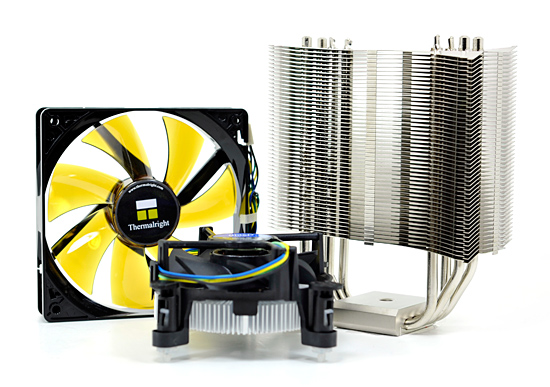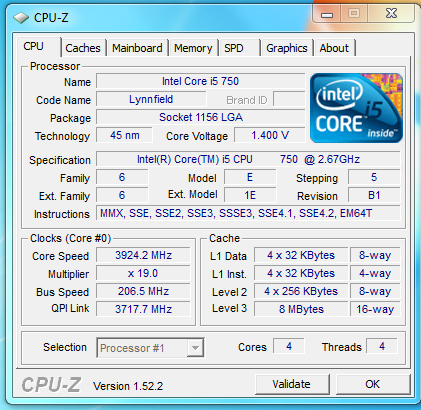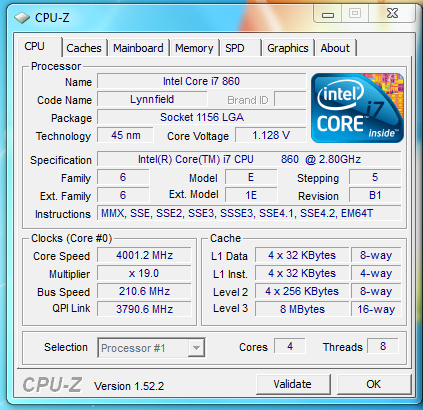Intel's Core i7 870 & i5 750, Lynnfield: Harder, Better, Faster Stronger
by Anand Lal Shimpi on September 8, 2009 12:00 AM EST- Posted in
- CPUs
Overclocking: Great When Overvolted, Otherwise...
Back when I asked Intel why anyone would opt for LGA-1366 over LGA-1156 one of the responses I got was: overclocking. The most overclockable CPUs will be LGA-1366 chips.
We tried overclocking three different CPUs: the Core i7 870, Core i7 860 and Core i5 750. We overclocked using two different coolers: the retail low profile HSF and a Thermalright MUX-120 (the heatsink Intel is sending around to reviewers for high performance testing). I'll get one thing out of the way: the retail heatsink pretty much sucks for overclocking:
| Intel Core i7 870 | Max Overclock (Turbo Disabled) |
| Intel Retail LGA-1156 Cooler | 3.52GHz (160MHz x 22.0) |
| Thermalright MUX-120 | 4.20GHz (200MHz x 21.0) |
The Thermalright enables higher overclocks by removing heat quickly enough allowing us to increase the voltage to the CPU. While roughly 1.35V is the limit for the retail cooler, The Thermalright MUX-120 let us go up to 1.40V. In both cases you need to have a well ventilated case.

Um, yeah.
Now for the actual overclocking results. We overclocked in two ways: 1) with turbo mode enabled and ensuring stability at all turbo frequencies (both single and multiple cores active), and 2) with turbo mode disabled simply going for highest clock speed.
The results are in the table below:
| CPU | Stock Clock Speed | Max Overclock (Turbo Enabled) | Max Overclock (Turbo Disabled) |
| Intel Core i7 870 | 2.93GHz | Default: 3.39GHz (154 x 22.0) 3C/4C Active: 3.70GHz | 4.20GHz (200 x 21.0) |
| Intel Core i7 860 | 2.80GHz | 3.23GHz (154 x 21.0) 3C/4C Active: 3.54GHz | 3.99GHz (210 x 19.0) |
| Intel Core i5 750 | 2.66GHz | 3.2GHz (160 x 20.0) 3C/4C Active: 3.96GHz | 3.92GHz (206.5 x 19) |
For best performance with all four cores active, disabling turbo mode is the way to go. Otherwise you have to reduce the BCLK in order to make sure your system is still stable when the one-active-core turbo mode kicks in. For example, with our Core i7 870 with turbo disabled we hit 4.2GHz using a 200MHz BCLK. If we used the same BCLK but left turbo enabled, when only one core was active we'd hit 5.4GHz - clearly not realistic with only air cooling.
The benefit of leaving turbo enabled is that you get a more balanced system that's not always using more power than it needs to.

The Core i5 750

Our Core i7 860 sample wasn't that great of an overclocker

Breaking 4.2GHz with our Core i7 870
At roughly 4GHz overclocks for all of these CPUs, it's reasonable to say that they are good overclockers. But how about with no additional voltage and the retail heatsink?
| CPU | Stock Clock Speed | Max Overclock, Turbo Disabled (No Additional Voltage) |
| Intel Core i7 870 | 2.93GHz | 3.37GHz (22 x 153MHz) |
The stock overclocks just plain suck on Lynnfield, you need added voltage to overclock the chip. With more voltage it works just like a Bloomfield or Phenom II, but at stock voltages Lynnfield just doesn't clock very high. And it has nothing to do with yields.










343 Comments
View All Comments
HexiumVII - Tuesday, September 8, 2009 - link
I must say that Lynnfield is the best stock processor ever. It will o/c itself without you having to touch it at all. Nearly perfect for the masses. I absolutely can't wait for the notebook incarnation.ClagMaster - Tuesday, September 8, 2009 - link
The performance of these processors is what I thought they would be based on your May Preview Article. Its great the NDA is lifted and we can now see what this processor can really do.This is hardly a Celeron. I know a troll in earlier Lynnfield/P55 that should be eating crow.
Apahutec - Tuesday, September 8, 2009 - link
Not sure what "core parking" priorities are (reduce power consumption by grouping tasks on active CPUs, or tune performance by taking into account cache trashing in scheduler decisions), but it sounds like it could even be beneficial on my Core 2 Quad: single socket, no HT, but two Core2 Duo (each with its own L2 cache) glued together.erple2 - Tuesday, September 8, 2009 - link
Sounds like it, but the logic that controls that on the CPU is on the CPU, and uses up a couple million transistors. That would require a re-spin of the Core 2 parts (which, given the P55 platform release, I think is a safe bet won't happen), however.Obsy - Tuesday, September 8, 2009 - link
I don't get how Turbo Boost ends "dual-core or quad-core?" I know that an on-die IGP is a selling point for the upcoming 32nm dual cores, but wouldn't they be clocked higher than these quads and have Turbo Boost too? There will be dual cores clocked higher than quads again. Or is Intel not clocking their dual cores past the speeds of quads?macs - Tuesday, September 8, 2009 - link
Would be interesting an article about P55 mobo with nf200 chip and 2 gpu...Ryan Smith - Tuesday, September 8, 2009 - link
We talked to NVIDIA about that scenario a couple of weeks ago. A NF200 chip would not make a significant difference in performance, which is why they're letting manufacturers go ahead and just split lanes with a straight-up bridge chip.Darkanyons - Tuesday, September 8, 2009 - link
Thanks for this great article!!Tomzi - Tuesday, September 8, 2009 - link
Do the PCIe controller's voltage demands impose stricter limits on undervolting in the case of Lynnfield processors compared to Bloomfield? I can run my i7 920 at stock frequncies undervolted to 0.9xx V VCore. How much voltage (power consumption) reduction can we expect from the an i5 750?This might not be a hot topic so close to the release of the new chips when everyone is focused on top performance comparisons but I've always been interested in undervolting/clocking and would like to see a more complete picture.
Tomzi - Tuesday, September 8, 2009 - link
750 and 870 undervolted by ~0.1V reported on silentpcreview.